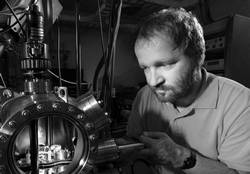Will Allow Businesses to Store 100 Times More Information
 After 30 years of painstaking research and investing billions of dollars in nanotechnology, International Business Machines (IBM) scientists have rocked the modern scientific world yet again.
After 30 years of painstaking research and investing billions of dollars in nanotechnology, International Business Machines (IBM) scientists have rocked the modern scientific world yet again.
Since the dawn of modern computing, speculations of various calibers have plagued the question of how many atoms it would take to build a reliable magnetic memory bit. IBM’s research, published in the peer reviewed journal, Science, has shown that the numbers of atoms required to store a single bit of information, which now is generally stored in about a million atoms, has been slashed down to only twelve.
“Storage devices in 12 atoms?” said an awestruck Shivam Patel, sophomore biology major. “It is shocking to accept, but technology is growing at a rapid pace in society today. It may cost a fortune to produce these devices, but it consumes less, making it energy efficient.” Of the various forms of information computers can understand, the most basic type is a bit. Analogous to a door that can be only be open or closed, a bit can only have one of two values, “0” or “1.” The word “Think,” which is the corporate motto of IBM’s century old legacy, was encoded on an array of only 96 iron atoms. According to IBM.com, “a magnetic byte was imaged five different times in different magnetic states to store the ASCII code for each letter…one bit was stored by 12 atoms and there are eight bits in each byte.”
Marveling at this new research, Sam Broadbent, sophomore chemistry major, said, “The ability to make a jump from the most advanced storage system, which contained about one million atoms, to one which contains only 12 molecules shows what the scientific community is truly capable of.”
Dr. Robert Pastore, adjunct professor of physics, believes that “gigantic amounts of storage will be available in the next couple years. This research may lead to microprocessors base in quantum mechanics which can be utilized to solve big problems.”
Possessing similar properties to the magnets on your refrigerators, the ferro-magnets used by IBM have a unidirectional spin, which is the origin of the atoms’ property of magnetism.
They are, according to IBM.com, a major obstacle for downscaling magnetic data storage to the atomic scale because of the inevitable interaction of neighboring bits with each other due to the presence of magnetic fields.
Consequentially, the harnessing of atoms to perform useful work requires an incredibly precise command of the quantum interactions between the bits.
This is accomplished via a scanning tunneling microscope (STM) that allows scientists to actually manipulate the atomic configuration of the 12 antiferromagnetic ally coupled atoms that were used to store the bit of data for hours on end near absolute zero (about 460 degrees Fahrenheit). The STM cannot only be used to capture images of atoms but also reposition individual atoms, much the way a billiard ball might be moved by a pool cue with a sticky tip, according to the New York Times.
By harnessing the power of the STM, researchers have now gained the power to pack adjacent magnetic bits closer to each other than ever before, whereby significantly
“[amplifying] the magnetic storage capacity without disrupting the neighboring bits,” according to IBM.com. “As a result, these new magnetic storage devices are at least 100 times denser than, “today’s hard disk drives and solid state memory chips.”
“This is really where we live,” said Andreas Heinrich, the lead investigator into atomic storage at IBM Research in Almaden, California, reported by the New York Times. “If you step outside of the press release, we are trying to control the quantum mechanics of this spin behavior to coax them to do whatever we want them to do.” In the future, this novel type of nanostructure will allow businesses to construct storage devices that can store upwards of 100 times more information in the same amount of space. The applications of this research are spilling on the tabletops of every branch of society as we live in an increasingly technologically advancing world.
As if it was a biological enzyme, technology has catalyzed the progress of our world in almost every facet of society, from transportation to telecommunication, from entertainment to education, to render the world we live in and the tasks we perform routinely as nothing short of “magic” to an individual alive a hundred years ago.
By the way we are going, Siri may answer that for you by doing slightly more than answering witty questions. “The nation that discovers the next logic switch will lead the Nano electronics era and reap the economic rewards associated with it,” said Ian Steff, vice president for global policy and technology partnerships of the Semiconductor Industry Association.
PHOTO COURTESY of sandia.gov



